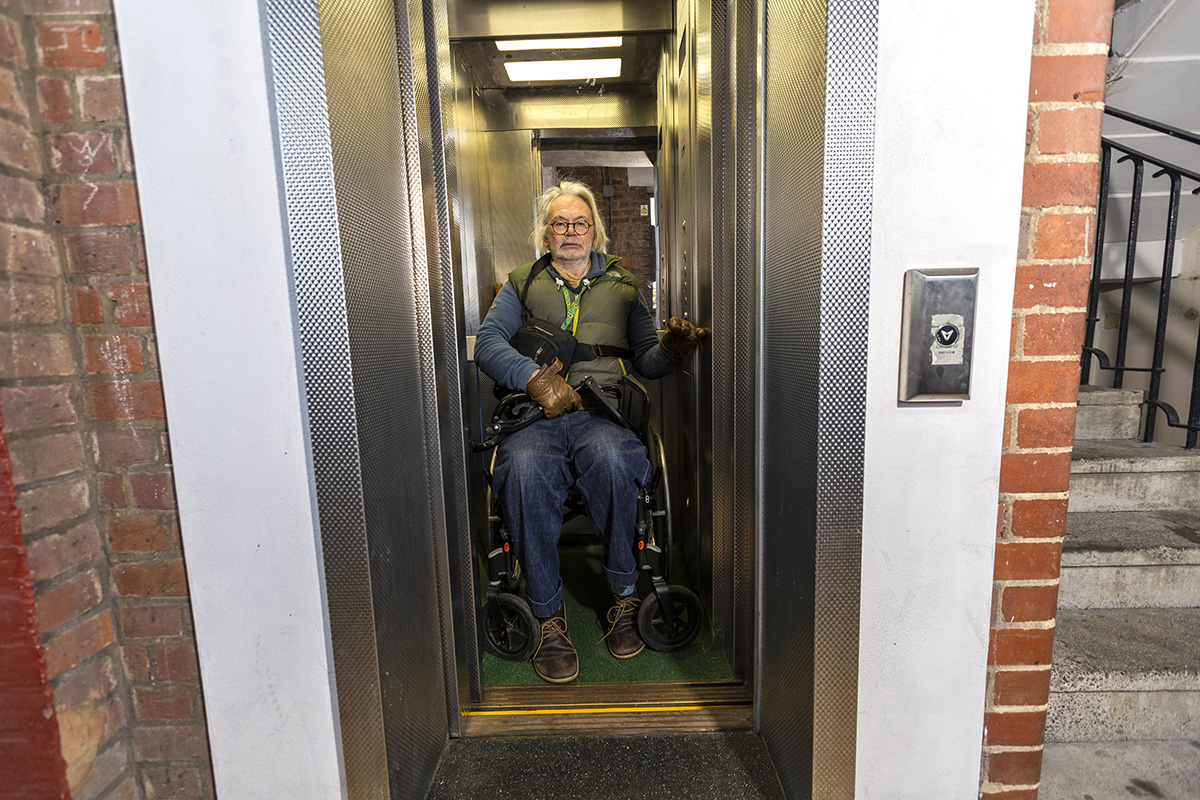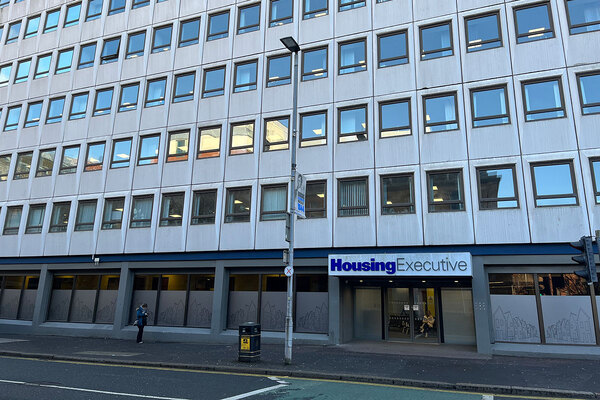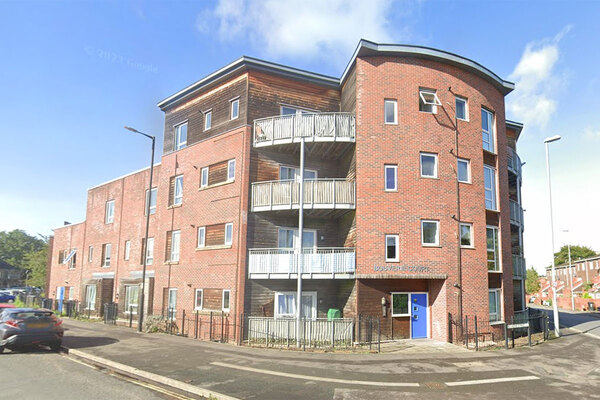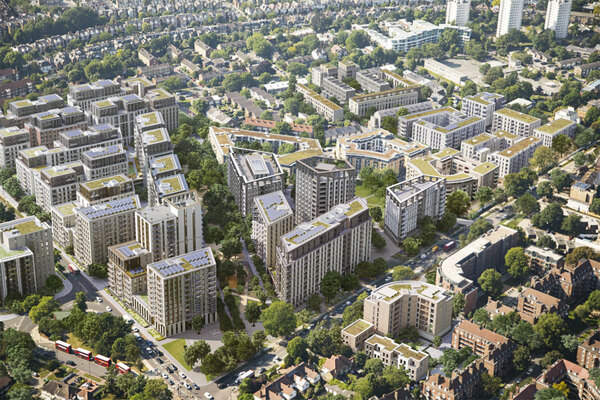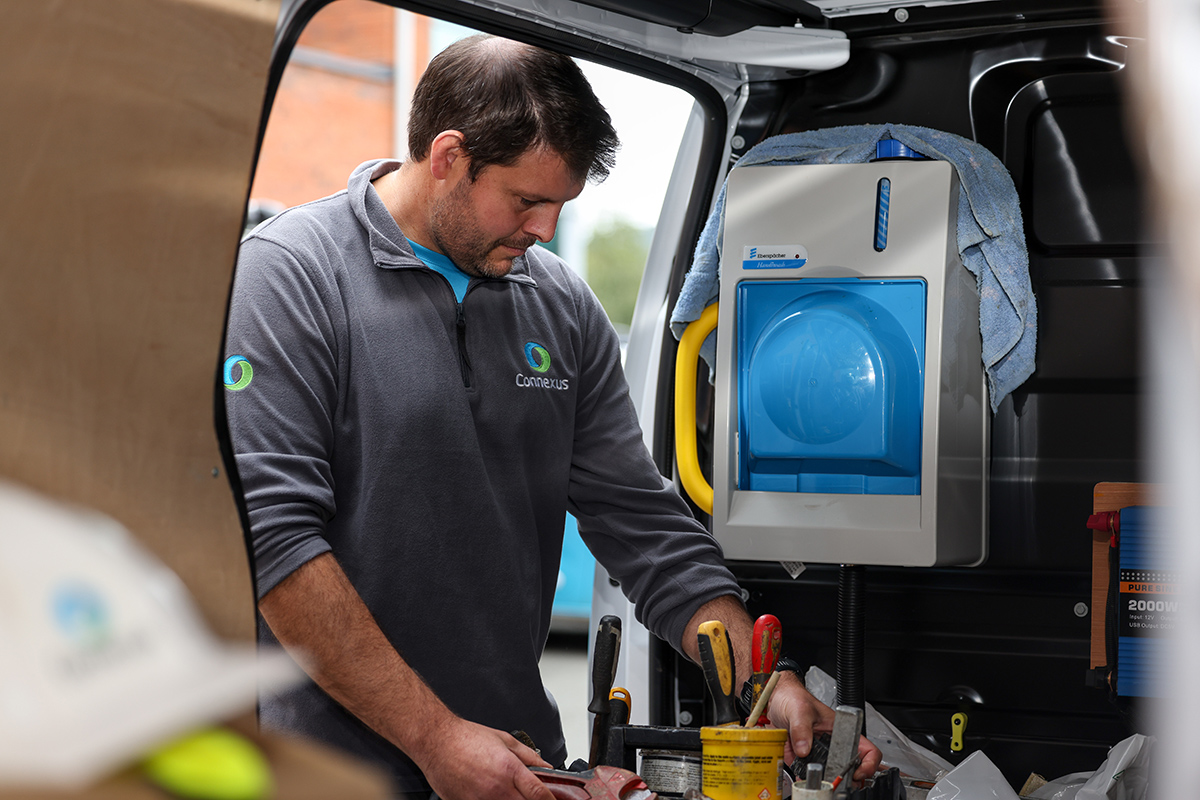You are viewing 1 of your 1 free articles
When a broken lift turns a home into a prison
On a number of occasions, Malcolm has been left stranded both inside and outside his flat for lengthy periods when his lift has broken down. He is far from alone, and with an ageing population and disability groups increasingly worried about the problem, what are the implications for social landlords and the government? Peter Apps reports. Photography by Sam Mellish
Malcolm lives on the third floor of a traditional-looking social housing block in Hackney, east London. Front doors of flats open onto deck-access walkways. This is ‘streets in the sky’ living – the dream of social housing architects of decades past.
Malcolm’s flat is neat and bright: books of manga and engineering principles line the shelves (an echo of his former career with British Aerospace), while the living room boasts an impressive array of thriving houseplants. It would be a nice place to live. But for Malcolm, who only wants to be referred to by his first name, it is all too frequently more like a prison.
The problem is under-discussed in the sector, but growing. Over the 15 years he has lived here, Malcolm has developed a series of complex needs and is now a wheelchair user with very limited mobility.
This makes him completely reliant on the lift to get in and out of the building. And the lift is less than reliable. In fact, he estimates that over the past three years, there have been 600 days when it has been out of order and he has been trapped in his flat.
Worse are the days when he does go out and returns to find an out-of-order lift. In these circumstances, he is stuck outside. In one instance, he had to phone an ambulance and nearly died of hypothermia.
“It affects every day of my life,” Malcolm says. “I don’t know if it’s going to be working when I go out, or if it will still be working when I come back. So there is this constant anxiety that I might be trapped.”
Trapped due to lift maintenance
In one instance, he came home in the middle of the afternoon but was not able to get back into his flat until 2.30am.
“It was breaking down sometimes 10 minutes after they left, breaking down every other day,” he says. “They say they are obliged to send an engineer out within 24 hours, but that’s not much good to me if I’m trapped outside in the evening. And even when engineers do come, they might not have the right parts, so someone else needs to come out, or they need to order the part. So sometimes something that could be a simple repair means I’m trapped here for a week.”
Malcolm says there was a solid three to four-month period last year when he was trapped without going out once due to lift maintenance. This severely affected his well-being. Even when it is working, the lift is very small, which means his wheelchair doesn’t fit. To use it, he has to back in and then partially disassemble his chair by taking the footrests off to allow the door to close.
Malcolm’s experience is indicative of a growing problem in the housing sector, and something which will become increasingly common as the years pass.
The average age of a lead tenant in the social housing sector is 53, which is 12 years older than the average privately renting tenant. Social housing also has the largest proportion of tenants with long-term illness or disability of any housing sector at 56%, and more than half have mobility issues.
The trouble is that – especially in bigger cities – a lot of social housing is in blocks of flats. Tenants like Malcolm who may have moved in many years ago have seen their needs change and are now in a block that is completely maladjusted for their needs.
This means a broken lift transforms from an inconvenience to a major welfare issue – especially in a single-lift block like Malcolm’s. Unfortunately lift maintenance does not seem to have kept up.
“Lifts are a huge, huge issue,” says Mikey Erhardt, a campaigner at the charity Disability Rights UK. “It’s certainly one of the most frequent things I get asked about. If it’s not ‘my lift isn’t working’, it’s ‘my block doesn’t have a lift when it really should’.”
“Lifts appear to be very shoddily maintained,” he adds. “The work is specialist and landlords seem reluctant to pay for it, so the quality of the repairs tends to be very poor and the lifts need to be fixed over and over again.”
He says the impact on residents can be profound. “When people know the lift is going to inevitably break, they stop using it and that means people stay in their homes more, become more isolated and often end up needing more support,” he says. “Social housing providers are often asking how they can get residents to trust them more, and wondering why relationships break down. But issues like this are fundamental to that.”
One problem is a lack of clear legal responsibilities. Case law on lifts tends to focus on the question of service charges and passing on costs to residents. But speed and, crucially, quality of repairs are legal grey areas. This is true more broadly for adaptations in common areas of blocks (as opposed to inside individual flats). A consultation in 2022 considered bringing into force schedules of the Equality Act 2010 for the common parts of multiple-occupancy buildings, which would have given disabled residents the right to ask for adaptations. But this has not yet been done.
This often leaves people in a position where they are living in a home which is no longer suitable for their needs. But when they ask to move, they run into a further problem: the lack of available social housing.
Malcolm put in for a transfer to a more accessible property three years ago. The problems extend beyond the lift: the layout of the flat doesn’t allow his wheelchair to move easily around the property, which means he needs to climb out and leverage around the flat using sticks to support himself. He has suffered accidents as a result, including one recently where he smashed his head into the door frame and nearly died.
There is also a lip on the front door which makes it extremely difficult to get the chair in and out of the flat.
He has had issues with leaks, which have cascaded through the electrical system and caused explosions. While this issue was being fixed, his lighting was put out of action for a month, meaning he was feeling his way around the flat in the dark.
However, the application for a transfer has progressed slowly. His landlord, Sanctuary, has told him it believes he should move into an older people’s home, but he is desperately against this.
He is in his early 60s, has full mental capacity and wants to live a normal, independent life.
“I would literally die if I went into an old people’s home. I would be smothered and lose my independence,” he says. “I need my own space and a mixed population. It would feel like I’m in a hospice.”
He has since been offered flats on the first floor with a single lift, which would raise the same issues as he has now, and a property with steps leading up to it, which another wheelchair user was moving out of because it was inaccessible.
“So now they keep saying, ‘We have offered you all of these properties,’ but none of them are suitable,” he says.
With the intervention of local councillors and his MP, he has now been told a first-floor property with two lifts has been earmarked for him. But there is a problem: he needs adaptations to be carried out before he moves in, but Sanctuary says he needs to provide his own occupational therapist assessment to enable this. But the NHS won’t do this until he is a tenant – and there is a 23-week waiting list even then.
For its part, Sanctuary notes the shortage of social housing in Hackney, where the wait for a one-bedroom flat of any sort is three years, and the borough specifically warns residents that “most people that join the housing register never get a social home even if they’re homeless, have significant medical needs or are living in an overcrowded home”.
A spokesperson for Sanctuary said: “While we understand the frustrations felt by our customer, and apologise for the concerns caused by the intermittent lift issues, the London Borough of Hackney is heavily oversubscribed with residents seeking transfers, which means waiting lists are lengthy for all housing bands.
“The property size required and small geographic area preferred by our customer has made finding suitable accommodation even more difficult, but he has been offered potential options, all of which he felt were unsuitable. We are pleased he recently viewed and accepted a two-bedroom flat we offered and we are committed to working with partner agencies to provide additional support to ensure the home meets his needs.”
Adapting stock
Clare Joseph, the Labour ward councillor who has assisted Malcolm, says: “As a councillor, I am well aware of the lack of social housing. Sadly we have other disabled residents in similar situations. Clearly we need more social housing and adequate government funding, but we also need housing associations who benefit from charitable status to properly consider their residents’ needs. Being trapped inside for months has a huge impact on people’s mental and physical health. They deserve better.”
All of this points to a major need for more accessible social housing, as well as adaptations to the existing stock.
Christina McGill, director of social impact at specialist housing association Habinteg, says the sector should commit to building all new homes to accessibility and adaptability standards.
“The age profile of social housing tenants is rising,” she says. “And we have got the oldest housing stock in Europe, the majority of which were built before accessible design was even thought about. It’s an immense challenge, but our view would be that any money that is going into social housing should be to homes that are inclusively designed and adaptable. That will then help to start to bridge that gap.”
This touches on another major issue for the sector currently: building safety. After the high proportion of deaths among disabled residents during the Grenfell Tower fire, the government has finally committed to the introduction of ‘residential Personal Emergency Evacuation Plans (PEEPs)’ for residents of high-rise buildings. The detail is yet to be released, but it is likely to involve identifying residents who would struggle to evacuate independently and making reasonable adjustments to ensure it is as easy as possible for them to do so.
Done properly, this issue will likely shine a light on what is a growing, hidden problem in the sector – and drive forward the need for adaptations.
Elspeth Grant, a partner at consultancy Triple A, says she is now aware of dozens of housing providers beginning this process. “It is being done, not widely enough, but it is happening,” she says. “People are going out and talking to their disabled residents, and working out emergency plans.”
This should be seen as part of a much broader challenge. As well as adapting our buildings to survive and mitigate climate change, we need to adapt them to be suitable for a population that is rapidly ageing. That needs to be built into strategies for maintaining and adapting as the years go by. But in the immediate term, it also means fixing the lifts.
Recent longform articles by Peter Apps
Cladding remediation: why is progress so slow?
It has been nearly seven years since the Grenfell fire, yet thousands of buildings are still in need of cladding remediation. Peter Apps investigates why the process has been moving at such a glacial pace
How a ‘Google Maps of heat loss’ might make retrofit easier to plan
Technology is opening up new ways to quickly assess which homes are leaking heat, making them a priority to retrofit. Peter Apps reports
What it is like to live in Nine Elms as an affordable housing resident
While the wealthy private owners of flats in Nine Elms enjoy the use of the swimming pool and orangery, affordable housing tenants are struggling to get repairs done. Peter Apps reports
The water will come: how should the social housing sector prepare for a wetter world?
Peter Apps looks at how social landlords should prepare themselves to respond to flood emergencies, which are set to become more frequent as the climate changes
The office-to-residential conversions which have become slum housing
Poorly converted office blocks are putting people in temporary accommodation at risk of serious harm. Peter Apps reports
Sign up for our asset management newsletter
Already have an account? Click here to manage your newsletters
